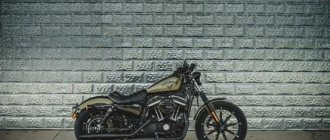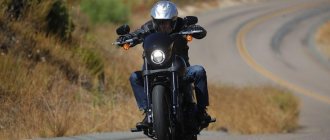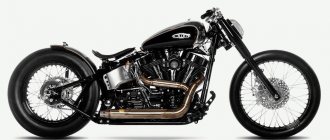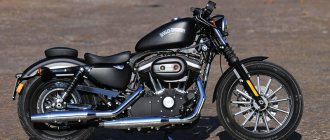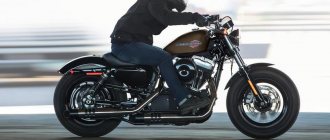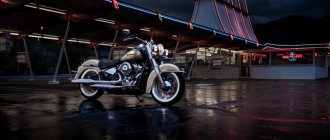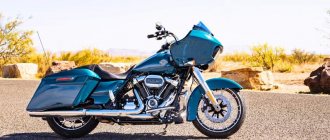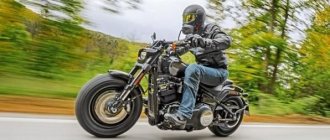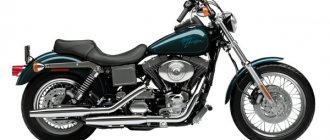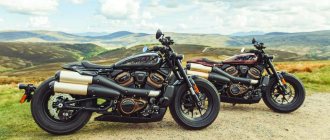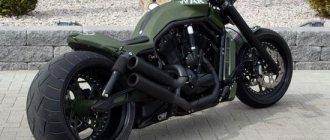The new Harley-Davidson Softail Slim FLS model is a kind of serial custom, made in the style of bobbers of the 1950s with an emphasis on the engine and with modern filling
Natalia Umnova
Harley-Davidson Softail Slim FLS. Price: from 1,066,500 rub. On sale: since 2012
The new production custom Harley-Davidson Softail Slim FLS has become for me an illustration of the previously little understood saying that “our shortcomings are a continuation of our advantages,” and vice versa. The whole point is a contradiction: I am a practical person (or not yet rich enough to afford two expensive motorcycles), and American motorcycles, like many cars, are taken for charisma and style, sacrificing a large share of comfort and “usability” for them.
So it is with the new “Slim”. He looks handsome! Large, low, black, matte, almost without chrome, with a wide handlebar, thick fork stays, large wheels, a huge headlight and far-out foot platforms. A real man, ready to submit to the will of a woman for a while, but clearly wanting strong male friendship: despite almost 320 kilograms of weight, parking it and driving it at slow speed was not difficult, but in terms of the landing and the reach of the steering wheel, it is designed for a taller and more powerful man driver.
Harley-Davidson Softail Slim FLS © Photo: Evgenia Lyubimova
The style is consistent, but what did you have to sacrifice for it? Of course, with the passenger seat. It would ruin the whole look. But according to the law of meanness, it was when I was testing the Slim that the urgent need to transport a passenger or strap down luggage arose several times. There's no point. Or here's the engine. The correct low-speed V-twin with a volume of 1690 cm3 with an impressive torque of 132 Nm, the peak of which already occurs at 3250 rpm. Unwinds with half a turn. But here it is, an infection - with air cooling: after 20 minutes of driving it starts to get so hot that you want to get off right away. I don’t recommend driving through traffic jams or on a hot day. But there’s nothing you can do about it - what kind of water-cooled Harley is that?! Loyal fans will peck themselves!
What about the saddle and harness? For the sake of style, the “tail” with a harsh small saddle and two shock absorbers imitates that very dry suspension - a mandatory feature of bobbers. It’s good that the fork is a modern “telescope” and not a “springer” from the 50s.
Harley-Davidson Softail Slim FLS © Photo: Evgenia Lyubimova
Tradition was nevertheless diluted with pieces of modernity: adequate ABS, an electronic display with indicators of average fuel consumption, revolutions, gear engaged, odometer and time, ignition with an immobilizer...
Harley-Davidson Softail Slim FLS © Photo: Evgenia Lyubimova
And the steering does not cause any complaints: even at low speed, the dimensions and weight are almost not felt due to the “flatness” of the device. After 120 km/h, vibrations begin, but who rides a Harley so fast: after all, those around him won’t have time to see him! It takes turns obediently at a speed corresponding to its status, and it also allows you to get through traffic jams, but somehow you don’t want to.
The front turn signals are attached to the steering wheel, and the rear ones, on the fender, have brake light bulbs built in - it looks very stylish © Photo: Evgenia Lyubimova
So it turns out: the Harley-Davidson Softail Slim FLS is a stylistically consistent device for those for whom status and appearance are most important, or who have another, more “down-to-earth” motorcycle in their garage for practicality and travel. In short, the Softail Slim is a motorcycle for Harley-Davidson lovers who will not notice its shortcomings and are unlikely to even assume that it has anything other than continuing merits.
The main drive is traditionally belt driven © Photo: Evgenia Lyubimova
Appearance of Harley-Davidson FXST Softail Standart
The Harley-Davidson FXST Softail Standard has a narrow, large wheel at the front, with a higher fork angle at the front and footpegs that are moved forward - this provides much better support. This moment highlights all the chopper features of this brand. The narrow and maneuverable Harley-Davidson FXST Softail Standard weighs 297 kg, because almost the entire line is constructed entirely of steel.
The rear suspension is trapezoidal, with suspended shock absorbers, and Harley-Davidson FXST Softail Standard wheels help the brand to handle long turns and difficult bends well. The wide handlebars make it easier to ride a heavy motorcycle. The large 21-inch wheel at the front makes steering possible in many situations.
Bikes of this type are designed with a special suspension at the rear, the appearance of which is specially made to imitate a rigid suspension. To achieve this, the shock absorbers at the rear are placed under the engine and mounted horizontally, and the pendulum looks like a triangular device. By 2000 These motorcycles are completely improved. They were equipped with an updated TwinCam 88 B engine, which for the first time in the history of the company had balancing shafts, a completely redesigned frame and modernized suspensions.
First part Second part
On to Sturgis!
Hoping that the new Sub Shock would create a stir among the tens of thousands of Harley fans who flocked to Sturgis, South Dakota, Davis and BM headed there in early August 1980 on the First Softail (based on the 1972 Super Glide) and the first motorcycle to feature the Sub Shock. ohm All the miles of previous road testing had shown that the new suspension mechanism worked perfectly, but a trip to Sturgis revealed a material problem that Davis didn't expect. The heat accumulating in the closed shock absorber gradually destroyed the polyurethane, and the cylinder sagged. As a result, the bike with the Sub Shock dropped lower and lower, and the suspension began to resemble a real hardtail more and more. Davis and BM decided against showing the new Sub Shock for two reasons - mostly because they weren't sure the shock would make it to Sturgis, but also because of BM's concerns about showing the bike before then. how the new system will be patented. BM took the Sub Shock bike back to St. Louis and Davis rode the First Softail to South Dakota. Bill's next misfortune came when he arrived in Deadwood - someone stole his things from his trunks. In a foul mood, Davis turned home without showing his bike at Sturgis.
Return of springs.
Davis didn't let the setbacks distract him. Arriving home from Sturgis, he began work on new springs and damper to replace the failed polyurethane structure. “I decided I could still use the tried-and-true metal springs and oil damper,” he recalls. “However, there was still a catastrophic lack of space for the location of the springs, and I decided to try die springs.” I couldn’t find a suitable term for them in Russian.) They are powerful and designed for many cycles of operation, but they are expensive.”
Davis needed small springs because the space provided under the transmission left so little room for shock absorbers that the springs had to be located inside his damper housing. “I mounted them under pressure, holding both springs with a press to enclose them in the housing,” explains Davis. “These were very expensive shocks to produce.” He also made them more capable of stretching rather than compressing, unlike other shock absorbers. “I designed my own pistons and valves system to make it work properly.” At this point, the Sub Shocks project was fully ready for production, and Davis and BMW took on another partner, a mechanic and fabricator, who helped them with tools and setting up frame production. “He was a very valuable addition to the team,” Davis recalls. He and Davis designed and built the tools necessary for production, while BM created a buzz with tons of promotional materials, even buying an entire page in the cult magazine Easy Rider for April 1981. The ad there showed the Sub Shock frame and the Wide Glide built on it. Looking at this bike, it's easy to see how little the design has actually changed on the factory Harley Softail.
Another collapse.
Even before the Easy Rider ad even aired, there was controversy within Road Worx. Most of the discord was on the conscience of BM, who began to get bored with the routine of office work. “It turned out that all the fun ended for him when the business went down the drain,” Davis recalls. The promotion showed every sign of success, although orders were received for only 21 frames. After meeting one last time, the Road Worx team built these frames and shipped them to customers. During this process, Davis and BM finally realized that they could no longer work together and ended their partnership. “You have no idea how much pain and horror I went through because of him. He turned every thing into a living hell." Road Worx died, but Davis was still on the hook for debt and loans. Lawyers advised him to sell the idea to other manufacturers. Before he had to reluctantly "crawl back" (Davis's own phrase) to MoCo, he tried to negotiate with several aftermarket manufacturers, investment groups and even Honda. The American department of Honda returned his proposal with a letter in which they wrote that they were not interested in unclaimed ideas. The rest simply offered ridiculous conditions. “I was so naive!” Davis said from experience. “I almost lost the rights to my patent among these sharks. Everyone wanted to take their piece.”
Rescue from HD.
With all these “amazing” options, Davis’s head was spinning, so he decided to call MoCo Jeff Bluestein. “He was still interested and made a much, much more interesting offer.” Davis consulted with lawyers. Even they thought the deal looked good, but there was one catch. Harley offered Davis a royalty on every copy sold. This was the good part of the deal. The bad part was that Harley insisted on a time limit on royalties. Davis tried to challenge this time limit, but Bluestein did not relent, citing the fact that Chief Vauch Beals was adamant on this point, regardless of how many motorcycles were sold.
“I didn’t like the idea of a time limit when we came to an agreement,” Davis recalls, “But my attorney said, ‘Get your patent, you won’t see any royalties!’” However, another point weighed heavily on Davis and his lawyers: “My patent was very weak in terms of design,” he admitted. “We were very worried that Harley Davidson would reproduce it anyway if we didn’t accept their terms.” Davis relented and signed the contract on January 6, 1982, selling Harley the Sub Shock prototype on the Wide Glide, the design patent, all the tools and six sets of frames with lower shock absorbers. All the turmoil with the contract was left behind, and Davis plunged into looking for work to stay afloat while waiting for the payments from Harley to begin. At first, he returned to customizing motorcycles, while simultaneously looking for a part-time job. “I remember I was unemployed (after the collapse of Road Worx) and in debt,” he emphasized. “Mr. Bluestein promised me more projects, but they never called again until I finally took a job at a medical company to make ends meet. First, I developed an ocular ultrasound scanning probe. Then we moved into urology ultrasound, and I developed the world's first ultrasound probe that could selectively scan the prostate in two dimensions simultaneously."
Softail production.
Fully loaded with work, Davis didn’t remember about his development until a year and a half later when his friends showed him a picture in a magazine in which the brand new Harley model looked exactly like the Sub Shock Wide Glide in the advertisement on the pages of Easy Rider. This was, naturally, the Harley Davidson Softail FXST with the new Evolution engine, which debuted in the summer of 1983 as a model for the 1984 model year. “The first thing I noticed was that they had changed the shape of the rear wing calipers,” recalls Davis. “My version was bent into an arc centered on the wheel. Willy G changed the shape due to his vision of the style, making them parallel to the mufflers. I think my version looked better."
Was Davis happy that his battle to bring the hardtail look back to market ended with a victory of this magnitude?
Not really. The memories of the torment were still quite fresh. “I was so sick of this guy (BM) that I didn’t care anymore,” Davis explained. “I didn’t love my development anymore, I didn’t care.” The indifference passed when he finally saw Softail live. With the usual carelessness of a creative engineer, for a long time he did not think about how good his basic design actually turned out to be. What had to be changed in the design for mass production and to please everyone in a huge company like Harley? Will they approve all of his decisions and compromises, or will they throw away most of them and make different choices? To his delight, Harley made no fundamental changes to the design. “They developed their own shock absorbers and bearings, but the triangular swingarm and stuff remained basically the same,” he noted. “I took it as a confirmation of my engineering abilities.” On the day of its appearance, Softail became the new star of the Harley Davidson lineup. Despite the high price, its sales exceeded those of all other Harley Big Twins and brought the company the necessary income that saved MoCo from bankruptcy. Harley was happy with how things were going, and Davis soon shared this happiness - as soon as sales royalties began to arrive. Harley Davidson quickly added new Softail models, and they also sold well, and the royalties just kept coming in. Eventually the deadline came and their flow dried up. However, Davis was not at all upset. “Of course, if there wasn't a specific deadline, I wouldn't have to work now,” he says, “but Harley's support was the bright part of this story; the rest was just hell." Although he was no longer receiving royalties, the company found work for him, taking him on several freelance engineering projects - some of which you may soon see at your local HD dealer.
Comfort Harley-Davidson FXST Softail Standard
The low seat has a well-thought-out shape, while the footpegs are installed in front, this creates conditions for better support. The passenger seat is not very comfortable compared to the driver's seat, but for a bike of this type it is quite comfortable. The passenger footrests are installed rigidly and placed quite low, so even a large person can comfortably rest their feet on them. Driving this motorcycle with many features.
The bike is quite stable, even from low speeds, and thanks to its not very large mass and low center of gravity, it does not require much effort to corner. In general, the bike is easy to drive and very obedient and does not take long to get used to.
Equipment
Over the course of several months, I tested Spidi leather gear in different conditions. Unexpectedly, it turned out to be tolerable in Teker Lady pants and a Gara Leather Lady jacket at temperatures up to +25°C: while driving they are tolerably ventilated, at short stops it’s also normal, but I still don’t have to stand on a motorcycle for a long time even in Moscow. It also got caught in the rain. The jacket withstood a half-hour downpour, getting slightly wet only in the areas of the nylon inserts. The pants also held up, but the nylon inserted in the groin to vent it failed: water seeped inside pretty quickly.
Zeta Lady gloves: ventilation helps in hot weather, in cold weather it is annoying, but for moderate temperatures most of the season they are suitable. The Arai open-face helmet is ideal for summer: ventilation and airflow from below keep your head cool enough to think.
Classic and modern: a digital screen on an analog speedometer and self-extinguishing turn signals, which, however, is sometimes not useful © Photo: Evgenia Lyubimova
Engine Harley-Davidson FXST Softail Standart
During the years when the Harley-Davidson FXST Softail Standard was produced, it was equipped with a TwinCam 88 B engine, which differed from the standard engine in the presence of 2 balancing shafts - this allowed the developers to be almost completely free from any vibrations. Some people will think that vibrations are typical for these motorcycles, but still, not everyone likes them.
Be that as it may, this engine deserves special attention. The engine receives fuel from the carburetor, engine capacity is 1450 cubic centimeters (injectors were installed on these variations), its power is 68 “horses”. And more than 100 Hm peak torque. The maximum speed of the bike is approximately 180 kilometers per hour, acceleration is just under 5 seconds.
This engine has tremendous power at low revs. But there is no upper limit; as soon as high revolutions are made, the traction disappears. During fast acceleration, at about 120-130 kilometers per hour, I want to turn on 6th speed, but, unfortunately, it is not there.
Narrow and perfect, a Harley with a mass of 3 and a quarter centners - this mass is not felt at all: a person with an average configuration and height can easily carry a motorcycle everywhere, without any effort. On the contrary, it will be difficult for a tall person with a Harley-Davidson FXST Softail Standard. Like the entire Harley-Davidson line, the described motorcycle has small dimensions, even though the frame of this bike is longer than many similar ones. As expected, a tall person will want to raise the steering wheel higher. But, no matter how you sit, the rider’s knees will comfortably hug the tank, designed to hold 17 liters.
Also, those who fell in love with the Harley-Davidson line are easy to complete and can be modified to suit your needs, thanks to this you can freely customize the bike to suit you. The suspension on the motorcycle causes mixed sensations - the thin fork at the front twists when driving long turns, while the shock absorbers at the rear look too stiff. But the first drawback can be easily eliminated by installing a third crossbar on the bike.
Stability is also not so great - the narrow front wheel and short wheelbase make the bike unsteady on poor road surfaces. But the maneuverability in the Harley-Davidson FXST Softail Standard is simply excellent. Regardless of the conventional chopper frame geometry and conventional fork rake, this bike is simply superb to handle.
In those distant times, when new Harley-Davidson FXST Softail Standart motorcycles could be bought at motorcycle dealerships, their cost was cheaper than their own kind, since it was a budget model.
Specifications
| Length | 2350 mm |
| Base | 1636 mm |
| Curb weight | 323 kg |
| Clearance | 114 mm |
| Fuel tank volume | 18.9 l |
| Engine | 2‑cylinder, V-shaped Twin Cam 103B air-cooled, 1690 cm3, 79 hp, 132/3250 Nm/min-1 |
| Transmission | mech., 5‑speed, final drive — belt |
| Dynamics | 180 km/h |
| Fuel consumption | 5.6 l/100 km combined cycle |
The editors recommend:
How to reduce washer fluid consumption?
Russians will be able to catch traffic violators on their phones
Where is it better to store a car - in a garage or outside? Opinions for and against
Advanced truck driver and savings on service: what do cargo carriers rely on?
New law: fine drivers for speeding 5 km/h
Discussion Cancel
Jem was right
You can feel the joy of communicating with this machine. Powerful kick, decent brakes, amazing sound coming from the two black exhaust pipes, and great comfort for a car in this class - it made me admire it. In turn, the slender, proportional silhouette and climate of the car led to the fact that, after getting off it, I looked at it with real pleasure, humming Jamie’s immortal verse under my breath: “Harley is mine, I love him...”.
Softail Slim S
Post Views: 1,885
Classic and modern
First I take the Softail Deluxe. An incredible amount of chrome, spoked wheels, deep fenders, white stripes on the sidewalls of the rubber, a “chandelier” of three headlights in the front - fans of Harley-Davidson retro style will be delighted! As soon as you sit down on the soft seat, put your feet on the huge platforms and grab the wide steering wheel, it immediately becomes clear that the Deluxe, like the bulk of large cruisers, is primarily designed for “long-range combat.” The driver's seating position is almost vertical, so the load on the hands is kept to a minimum.
Obviously, from an ergonomic point of view, the Deluxe (as well as the Fat Bob) was designed with that “big biker with a beard” in mind. It would even be appropriate to add “with foot size 45.” The brake pedal is striking in its monumentality, and the swinging “rocker arm” near the left foot is hard to call “gearbox foot.” To change gear or apply the rear brake, you will have to make some effort, which, however, within the framework of the “men's motorcycle” ideology is not perceived as a disadvantage. The clutch and front brake handles are also tight. Nevertheless, none of the controls have any problems with information content: gears are switched clearly, and the dosage of braking force does not cause any complaints. The only thing that made me suffer a little was finding a neutral gear - this was not always possible to do the first time.
Despite the appearance of a “fat man”, Deluxe demonstrates the habits of a good “classic”, willingly shifting from side to side in combinations of turns. The low center of gravity and small fork angle make the motorcycle control pleasant and predictable. The device does not tend to “fall” into the turn, which is the sin of many choppers. True, the width of the motorcycle is still too large for such active exercises: the foot platforms begin to scrape against the asphalt much earlier than you expect.
The updated Softail family fits the 103rd V-twin. A little more, a little more powerful, a little more elastic. The developers traditionally do not indicate the usual horsepower, but they hint that the updated engine has become 6% more powerful than the previous version. Subjectively, the engine clearly has more than 100 hp. – a heavy vehicle is capable of intensive acceleration both from a standstill and for overtaking from a cruising speed of 100–120 km/h.
The choice of the desired gear is now completely simplified - the torque of 138 Nm can be “taken out” even from 1000 rpm in fifth. There are six gears in total. The highest one is “tailored” for smooth driving on the highway – it’s nice to see 2000 rpm at a speed of 100 km/h. By the way, you can see the indication of the selected gear and engine speed on a small LCD display under the speedometer scale. You can also display odometer and clock readings here. The speedometer itself is traditionally located on the gas tank. It’s not very convenient, especially if you ride in a full-face helmet—you can only read the readings by tilting your head down. Well, design and heredity come first.
Naturally, the signature engine sound has not gone away, deep and rich, but at the same time not annoying with an excessive roar when driving on the highway at high speeds.
Almost everything said is also true for the Fat Boy, to which I replaced the Deluxe after some time. There is a difference in the seating position (due to the slightly different shape and location of the steering wheel), but in practice it is almost unnoticeable and does not affect comfort and controllability. But the Blackline stands out from the general style of the Softail model line. Narrower spoked wheels, a small headlight, a teardrop tank, a minimalist design - all the signs of an “orthodox” chopper are evident. The driver's position is also typical for this class: the driver's footpegs are further forward, and you have to lean towards the steering wheel.
The motorcycle retained an engine of smaller volume and power - 96 cc. inches (1580 cc). Nevertheless, due to the weight being slightly less than that of the Fat Boy or Deluxe, there is practically no difference in dynamics and comfortable speed of movement between these devices. And don’t look at the fork offset – the Blackline can be pushed even deeper into a turn!
One of the main topics that is invariably present in the conversations of experienced motorcyclists about Harley-Davidson is vibrations. One can argue endlessly about whether they should be retained as a signature feature or whether comfort is more important. The Softail series demonstrates a compromise on this issue. The engine's operation is heard and felt distinctly, especially at idle, but just enough to stroke the owner's vanity: yes, this is a Harley-Davidson! While driving, vibrations manifest themselves only as small tremors in the rear-view mirrors at speeds above 80 km/h.
You can fully enjoy the authentic “tremor” on Switchback. There are no balance shafts in the device’s motor, and the engine itself is traditionally fixed in the frame, using rubber silent blocks. That’s why Switchback turned out to be the most “shaky” of all the devices presented on the test ride. Tribute to the fans of the brand! But as soon as you start moving, the vibrations gradually “dissolve” and do not annoy the driver in the operating speed range of the engine.
Thirty-three heroes
The company of cars was a motley one: a pair of Softail Fat Boy Special, related Deluxe and Heritage, a Softail Blackline and two V-Rods, a Night Rod Special and a Muscle. Each of them has undergone a number of upgrades this year. Thus, for all motorcycles of the Softail family, with the exception of the Blackline, the “native” engine from now on becomes the 103rd Twin Cam (volume 103 cubic inches, or 1.7 liters), known to fans of the brand, which was previously installed on the company’s older models. The Blackline retained the 96V engine with a volume of slightly more than 1.5 liters.
The V-Rod is dressed in celebratory attire—it's its 10th anniversary, after all, as evidenced by the “10th Anniversary” inscriptions on the engine parts. The Night Rod sports inverted forks, a new rear fender, exclusive paint and a new exhaust system. The ergonomics have been slightly changed: the steering wheel has been lengthened and has become 7.5 cm closer to the driver, and the distance from the saddle to the driver’s footrests has also been reduced. The engine is the same, but thoroughly modified injection Revolution with a volume of 1250 cc. cm.
Exactly the same unit is installed in the frame of the updated Muscle. However, the motorcycle looks completely different due to a more aggressive plastic “body kit”, bright colors, a seat with a pronounced “step”, a 240 mm wide rear wheel and a matte exhaust system spread on both sides. This is not even a Power Cruiser, but a real dragster!
The highlight of the program is a completely new model in the Dyna line – Switchback. The motorcycle is positioned as a dual-purpose vehicle. No, don't think about it, Harley-Davidson has not started producing touring enduros. The Switchback cruiser is equipped with hard plastic panniers and a large glass that can be removed in just half a minute, and then the bike turns into a city version. The model is also equipped with a 103 cc engine. inches (1,700 cc), large headlight and two-into-one exhaust system inspired by the Road King touring model. At the same time, all devices received ABS in the brake drive and the Smart Security System anti-theft system as standard equipment.
